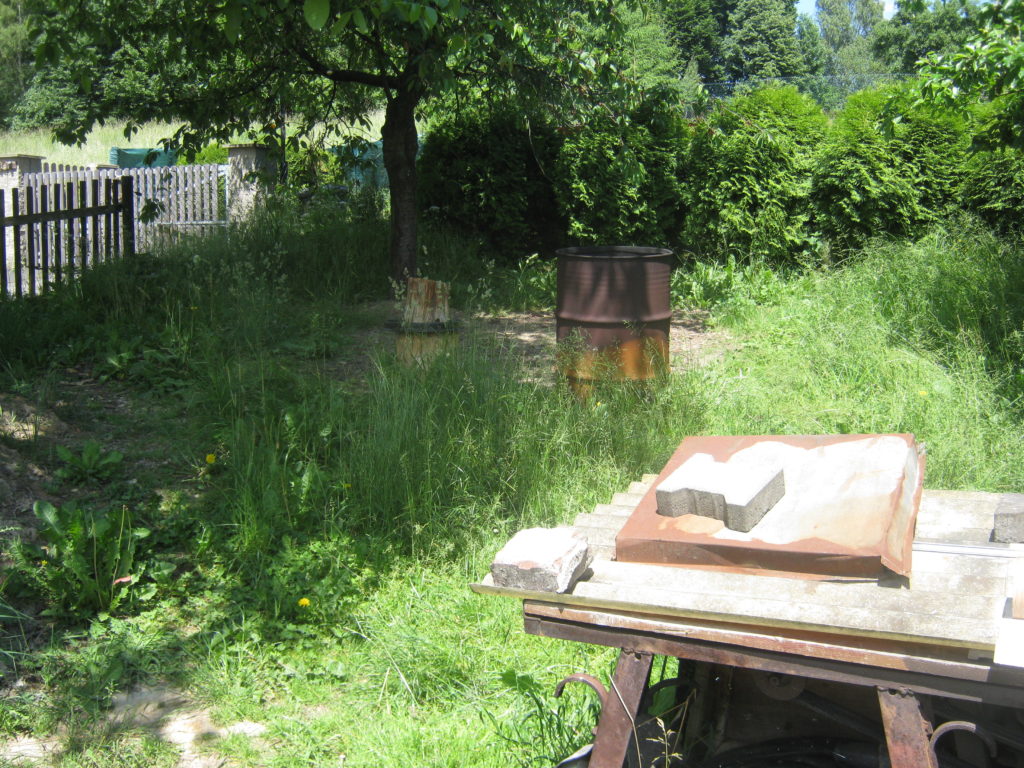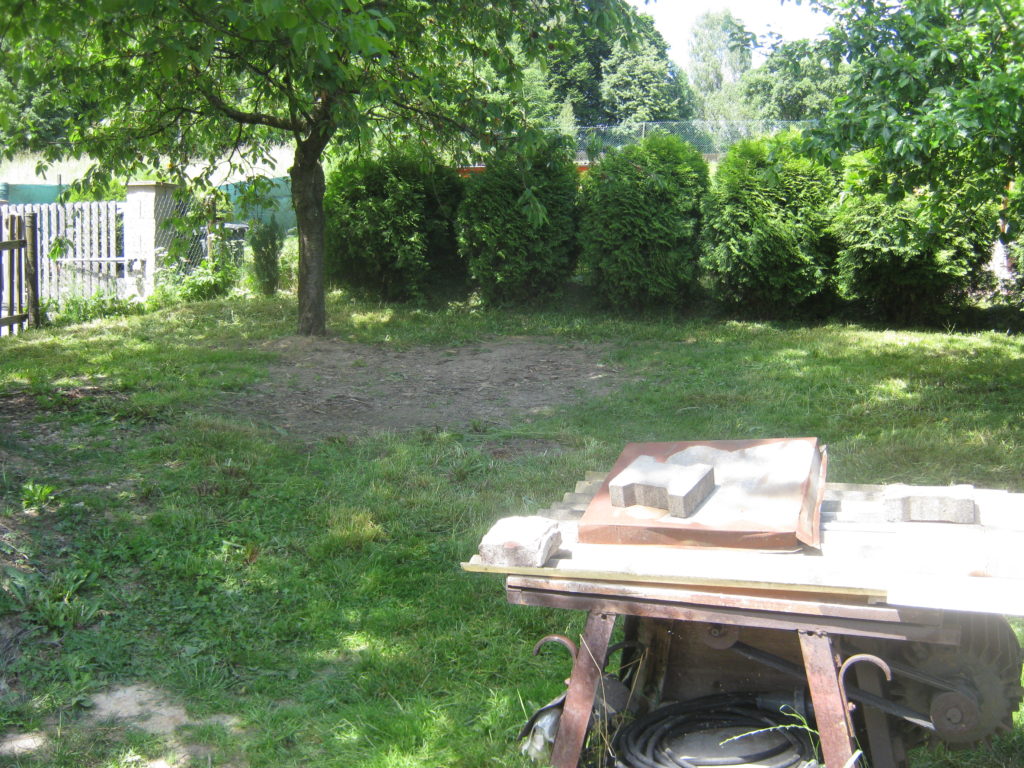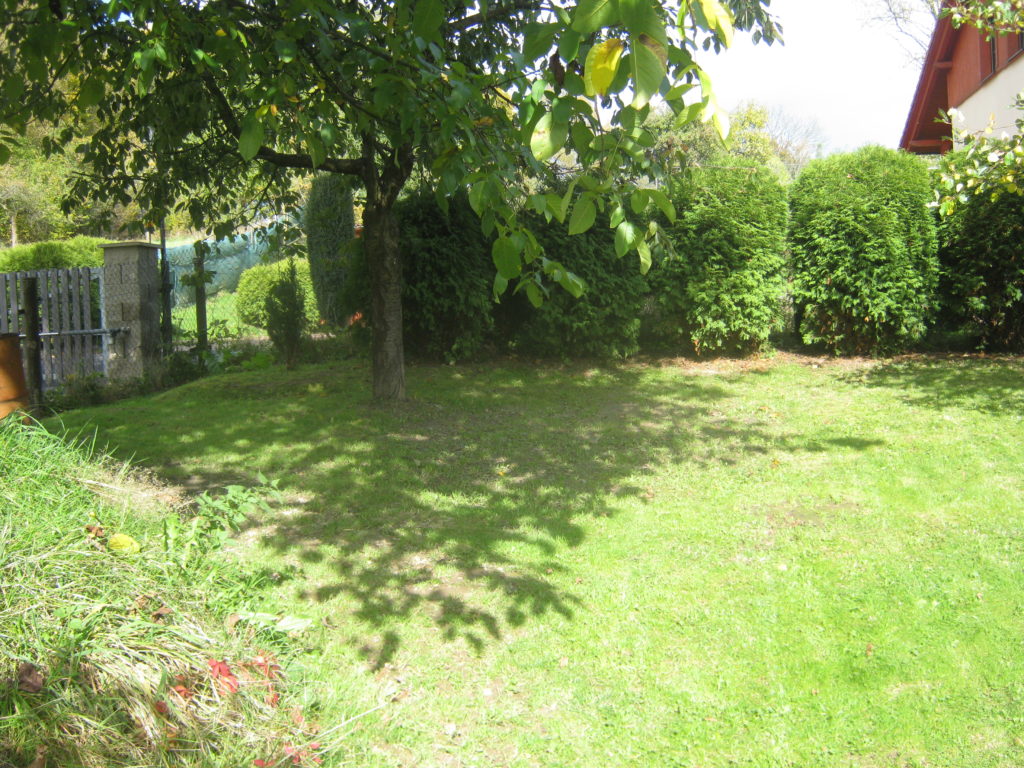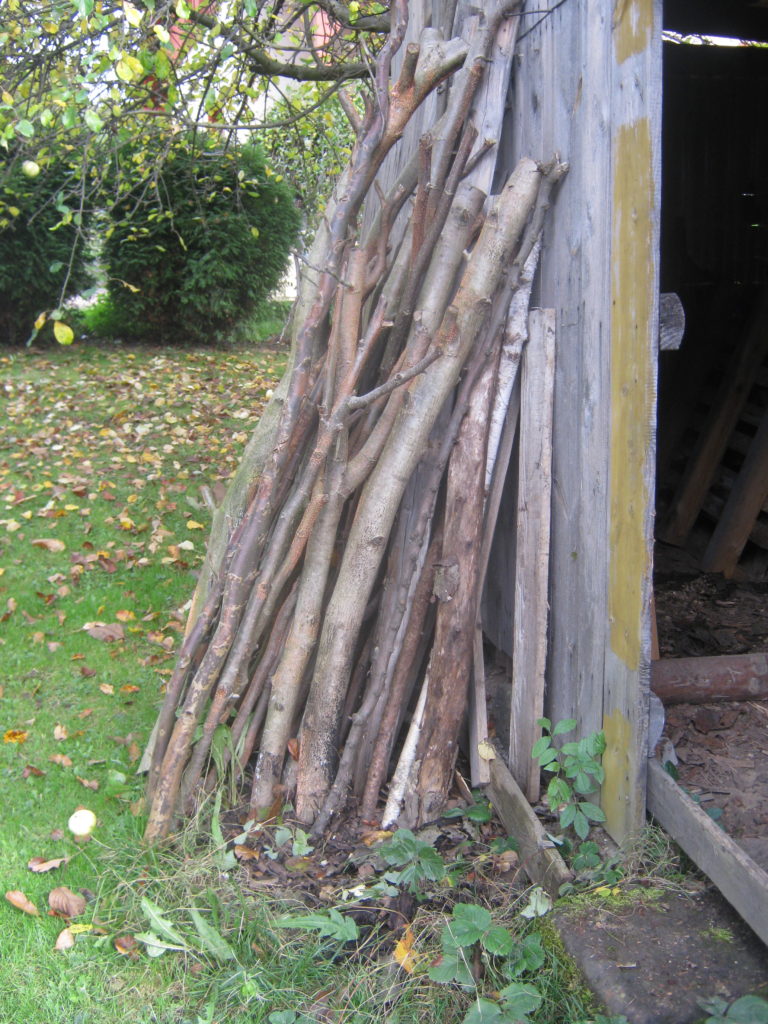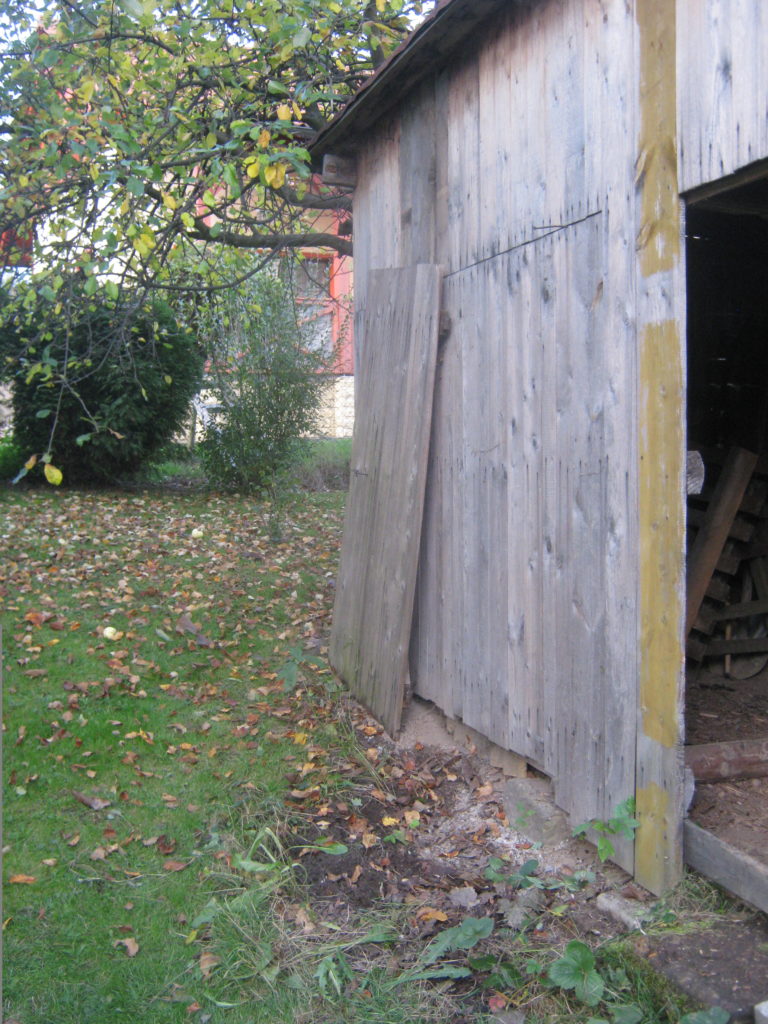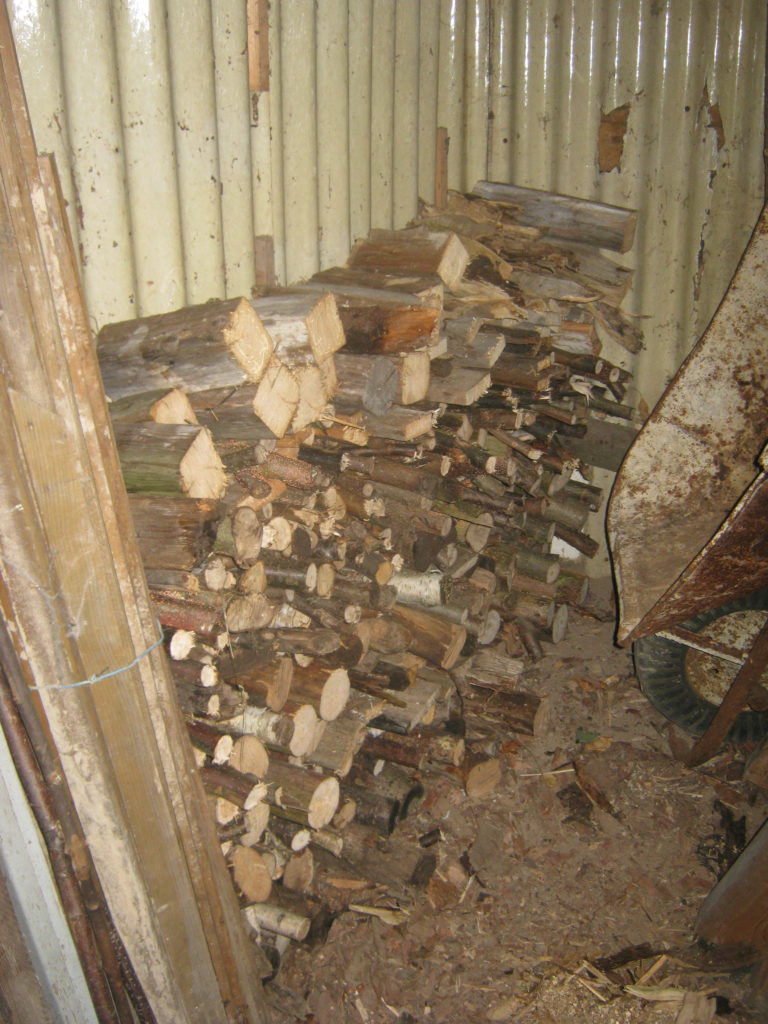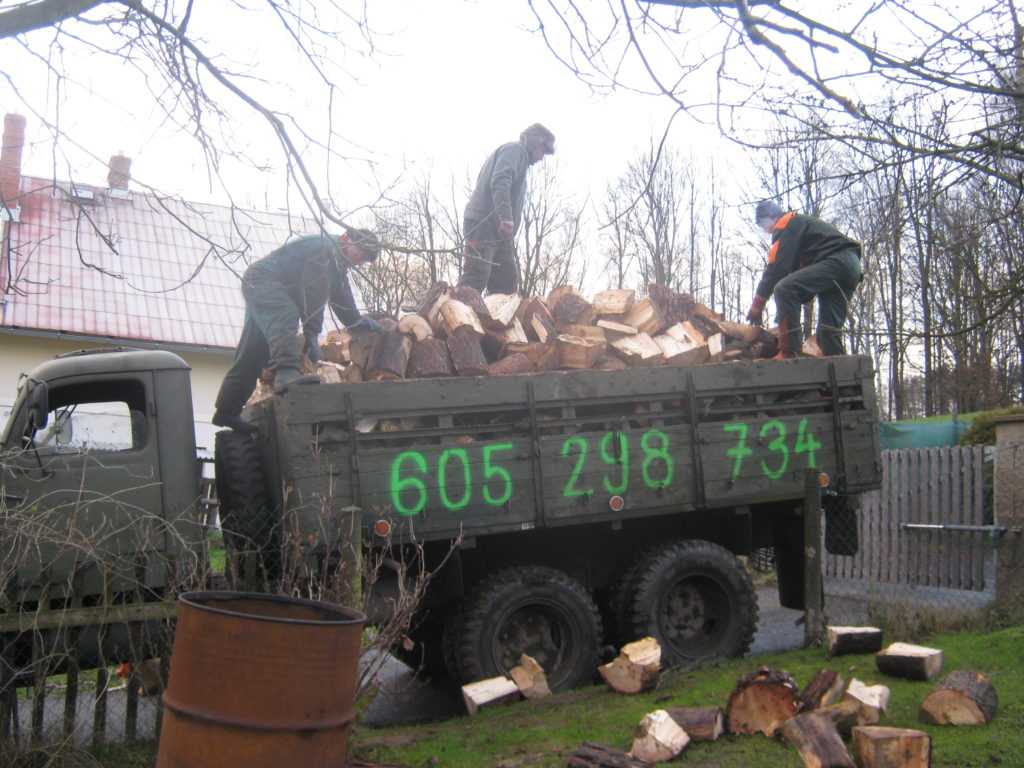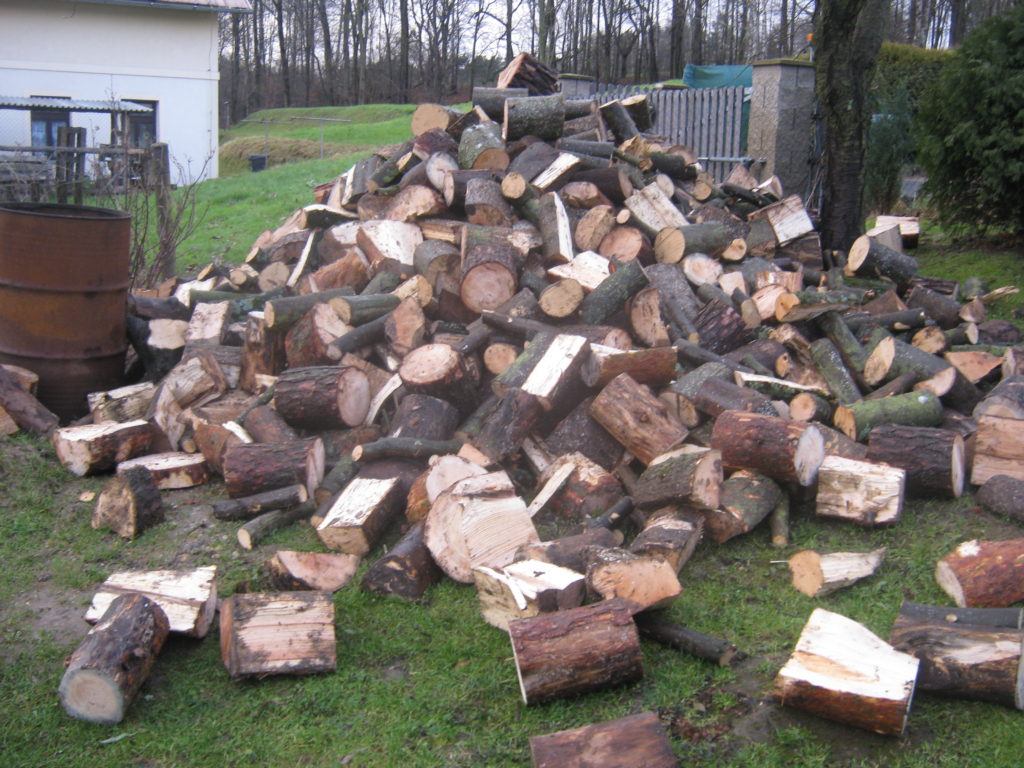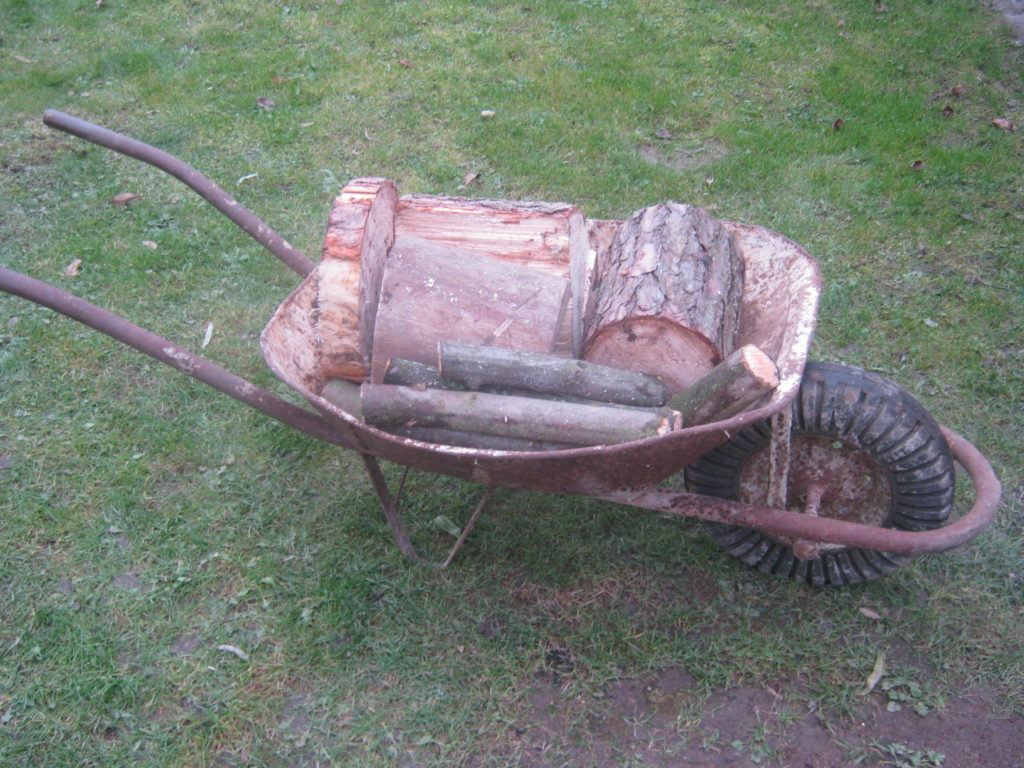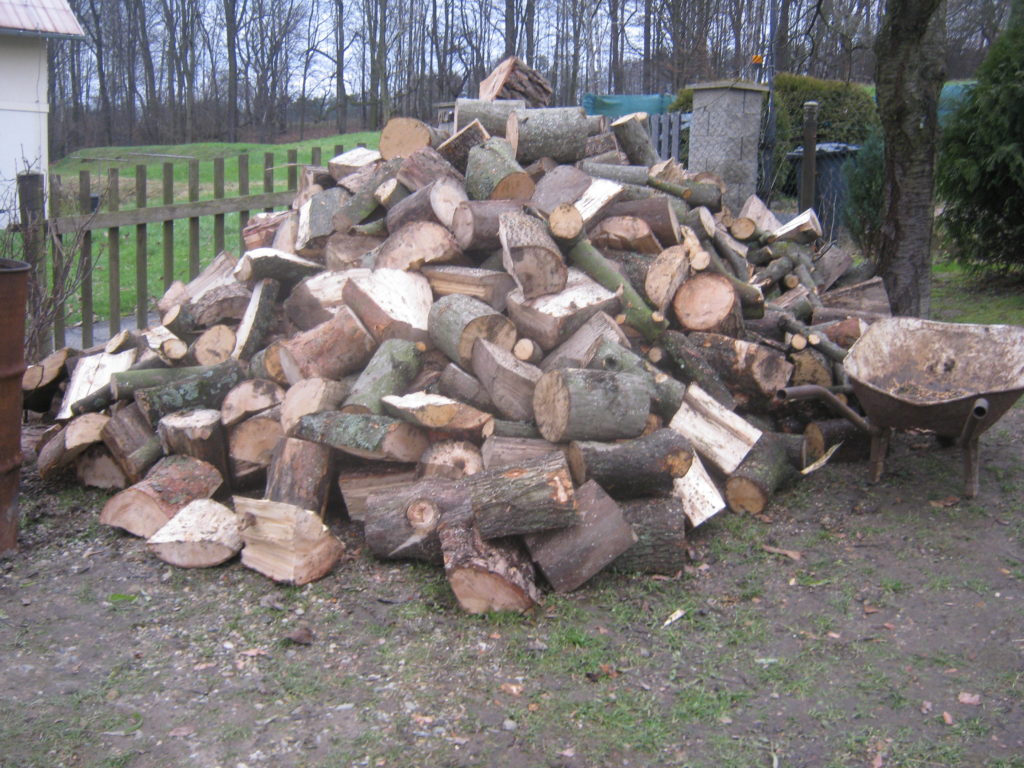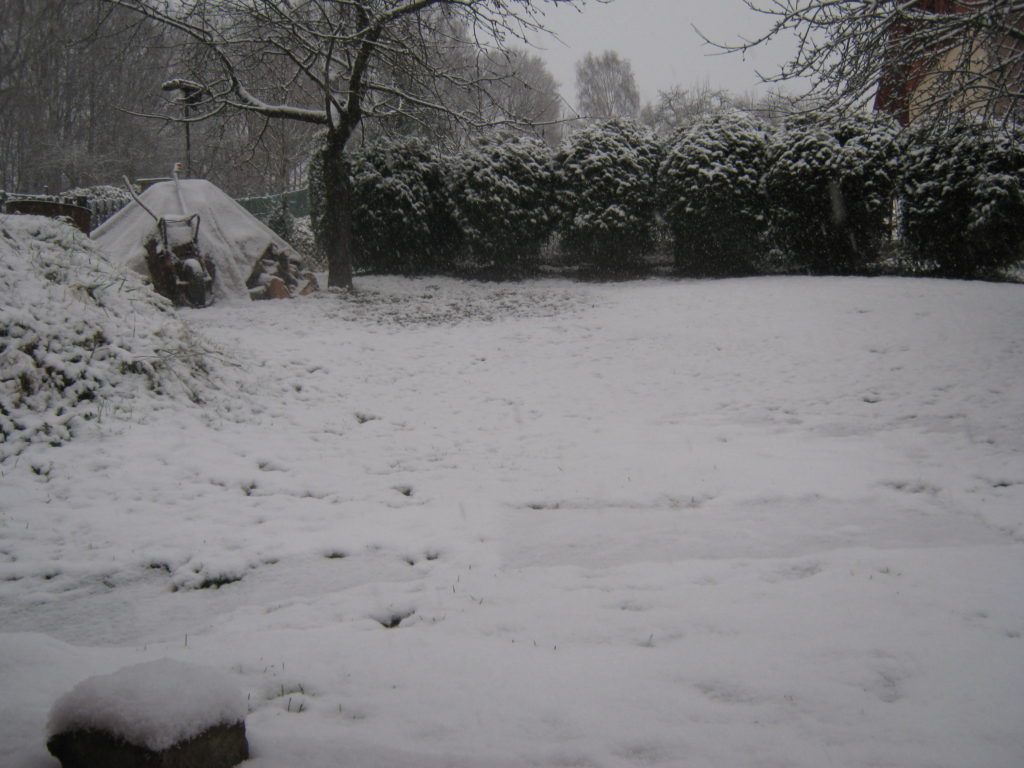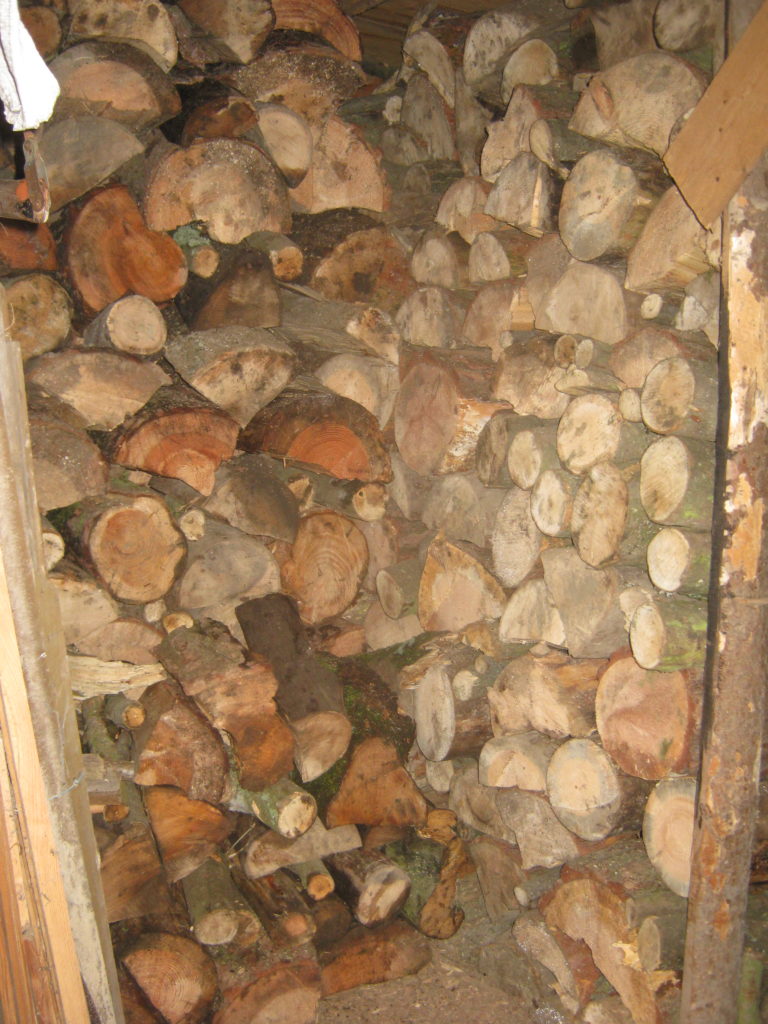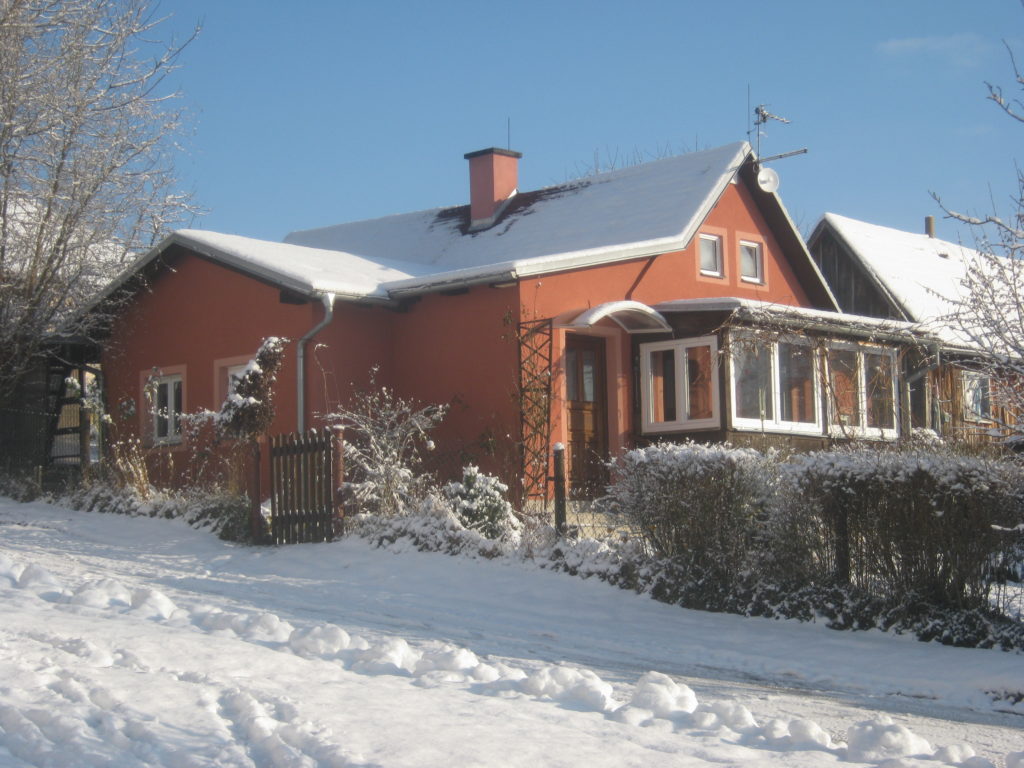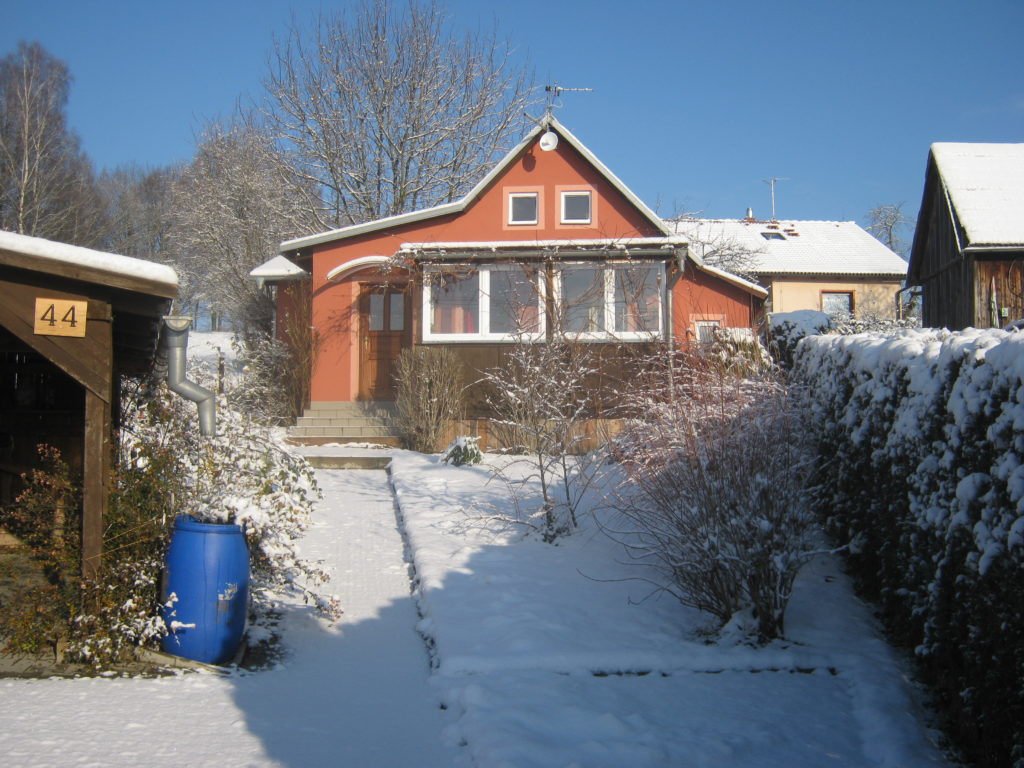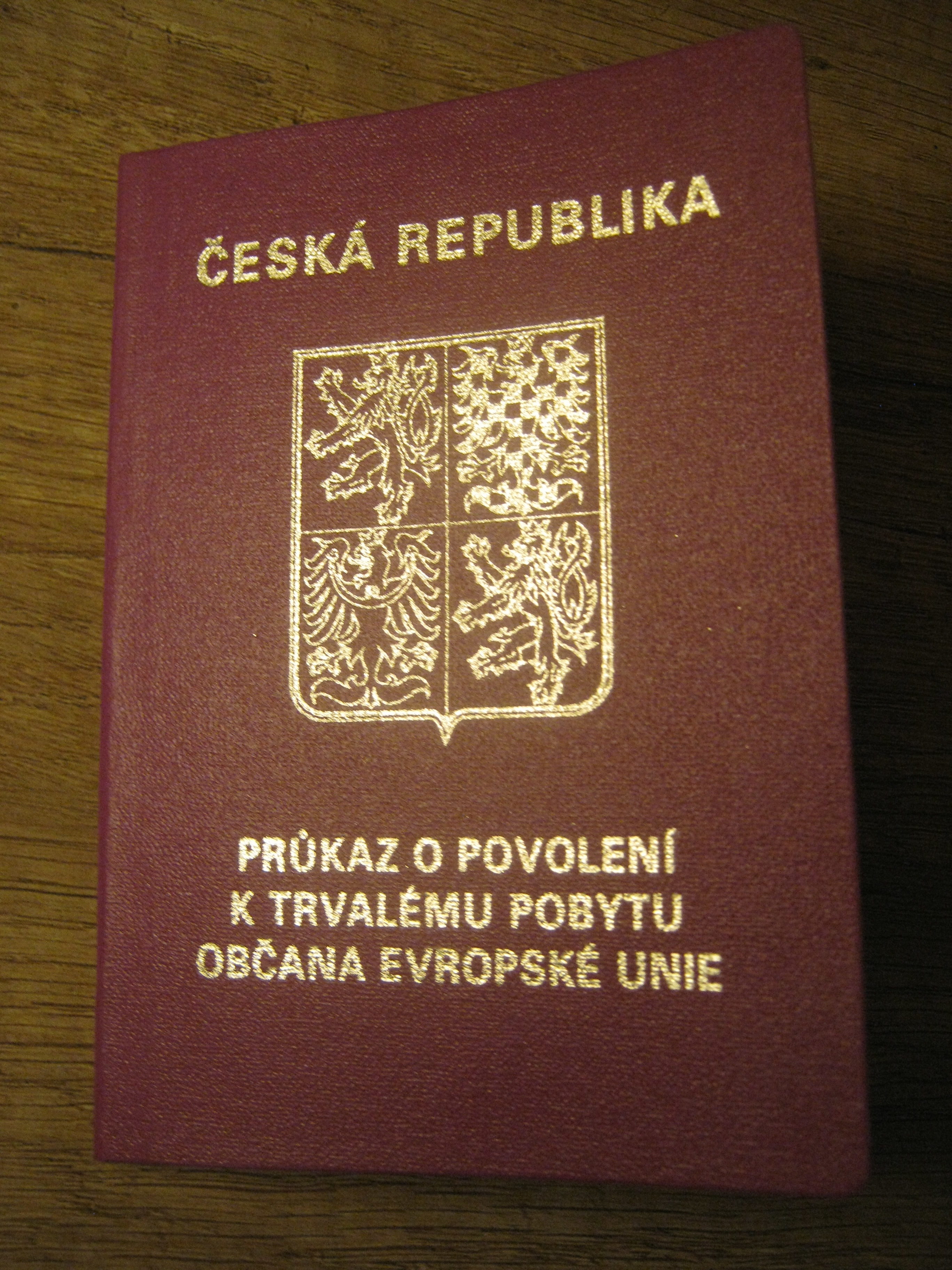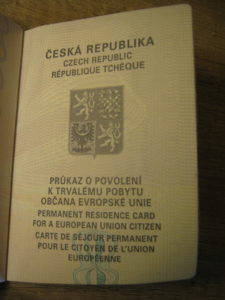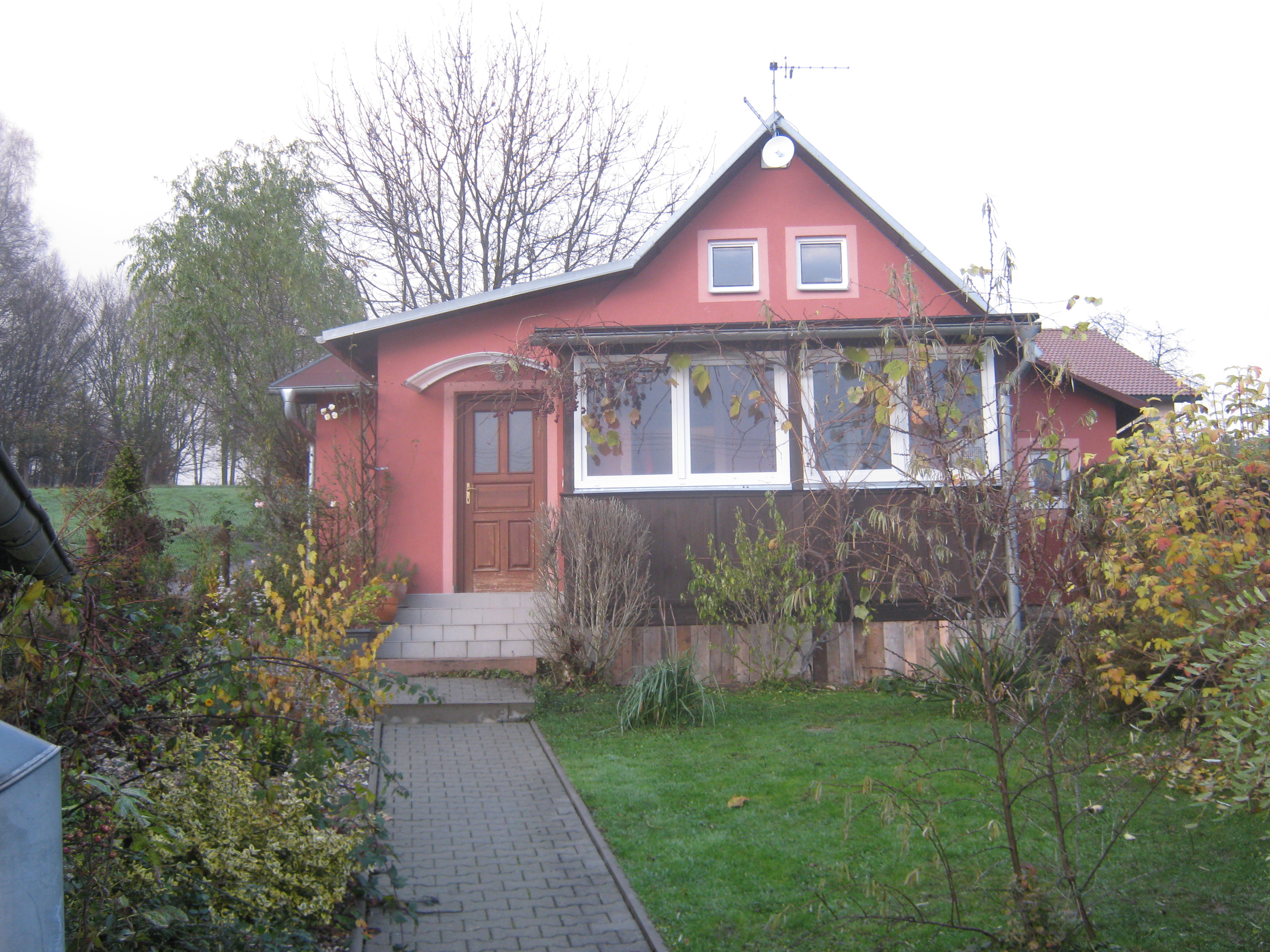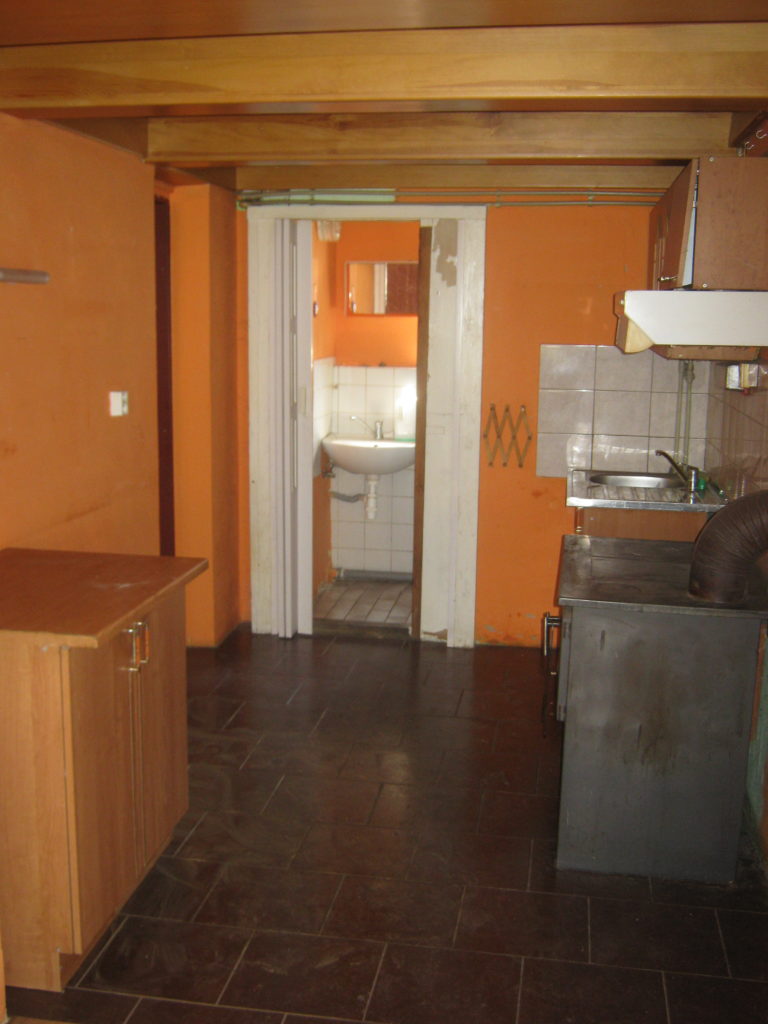
My sincere apologies for the for the absence of any new posts here since very early January. The main reason is in the title of this one. On Monday 8th January, I began a period of just over three weeks, living in the middle of a building site.
When I purchased my new home in Stará Oleška, I knew I would need to have the kitchen completely refurbished. As you can see in this photograph, taken after the previous owners had moved out but before we moved in, the only fittings were a sink, one floor unit, three small wall units, together with a wood-burning stove.
When I first viewed the house back in March 2017, there was still snow lying in the back garden, so having the wood-burning stove roaring both for heating and cooking, made perfect sense. But I knew that in summer, I wouldn’t want to have it going in order just to cook, when the temperature outside would at times be in excess of 30°C.
Therefore in advance of moving in, I purchased a simple electrical unit with two hot plates, that plugged into one of the wall sockets. This was my only means of cooking over the summer months, hence many regular visits to nearby Restaurace U Soni 🙂 But in September, I set about finding a firm who would completely refurbish the kitchen, including installing an electric cooking hob and oven.
I was recommended, once more by my real estate agent Martin Tonder, to a firm in Decín with the delightful name of Elefant. Fortunately, Martin and Ondrej, the two sons of the owner Mr Bulva, both work for their father’s business and both have reasonable English. After discussing plans and choosing kitchen units with Ondrej, it was agreed that a house visit was needed, to see if what I had in mind was feasible.
On the afternoon of Tuesday 24th October, Martin and Ondrej, along with their father, ‘the boss’, came to visit the house. The boss confirmed what we had previously agreed, that they would have to build a low heatproof wall, either side of the wood-burning stove, to protect the new neighbouring kitchen units. He also said what I was expecting, that there would need to be new electrical wiring, trip switches etc, because of installing a cooking hob and oven.
But he also told me what I feared, that the wall at the far end of the kitchen, beyond which is the shower room, was made of wooden boarding and not strong enough to support new kitchen wall units. It would have to be rebuilt. He also pointed out that the wall above the washbasin in the shower room, which is an outside wall, was extremely thin and lacking insulation. In simple terms, as well as refurbishing the kitchen, the shower room would also need to be rebuilt.
Just over a week later came the promised quotation, which included a contingency amount, depending on exactly what they discovered once the shower room was taken apart. I paid a deposit of CZK 50,000 and a start date of Monday 8th January 2018 was agreed. They couldn’t begin any earlier because of being busy with other projects.
At 08.40 on Monday 8th January 2018, just as promised, workmen arrived, along with the boss and Martin.
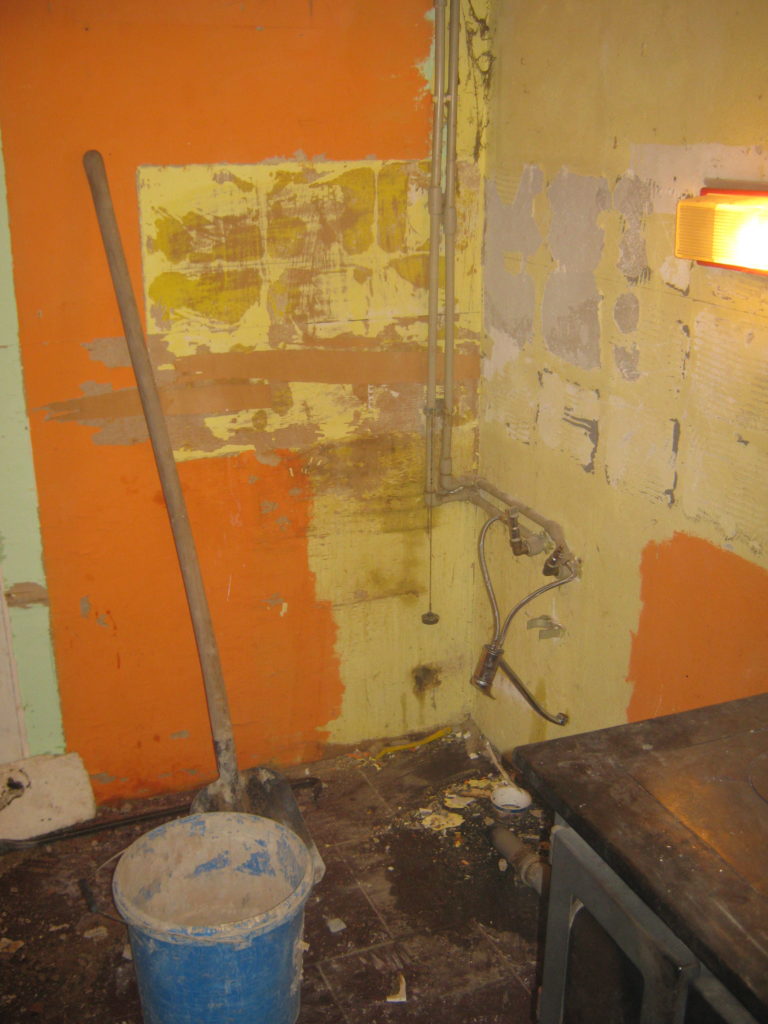
It didn’t take long to gut the kitchen. Here is where the sink and wall units once were.
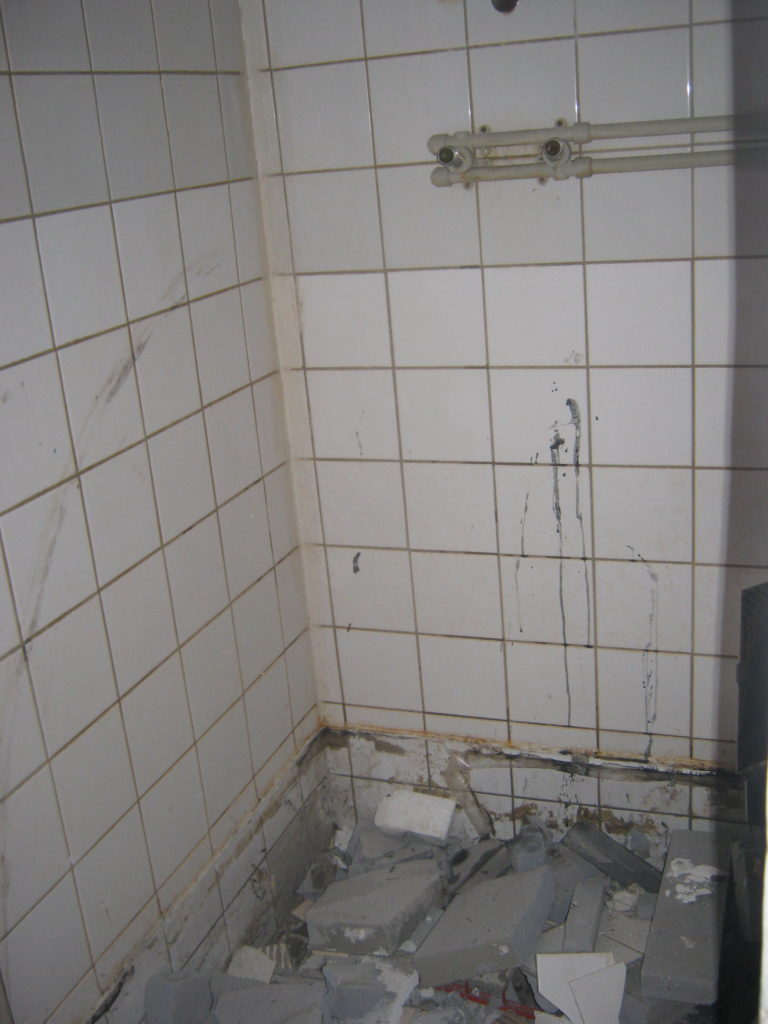
And this is the shower room, already minus the shower 🙁
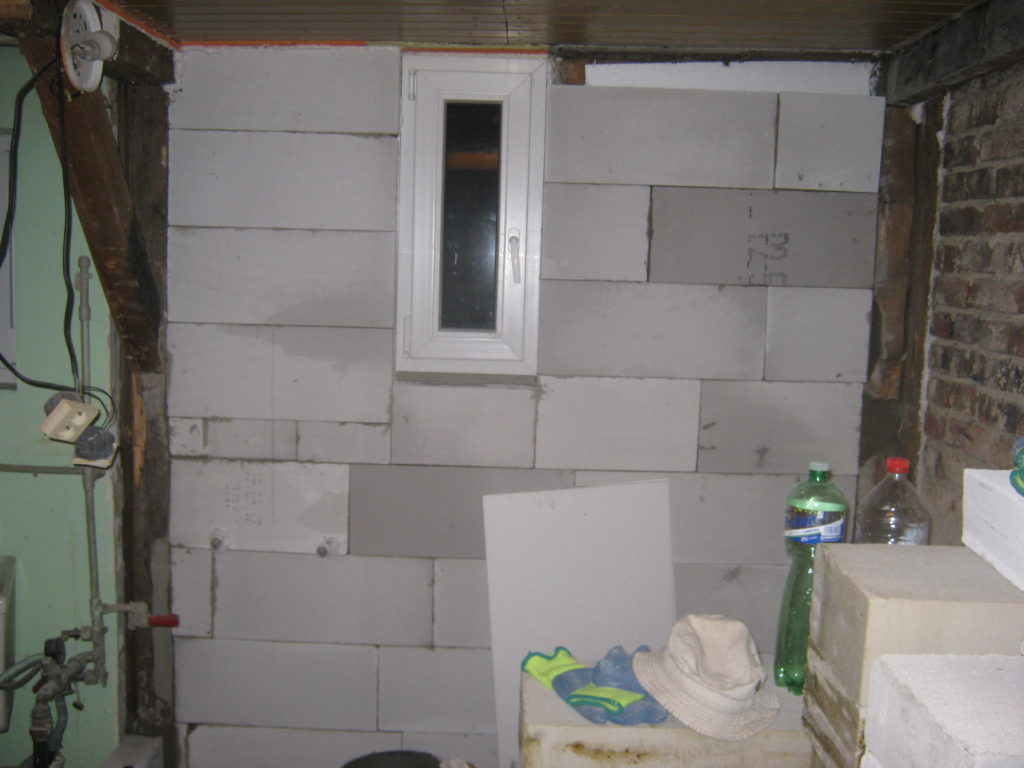
Following demolition, rebuilding began. Here is the outside wall of the shower room, insulated and re-lined with breeze blocks. On the left is where the dividing wall with the toilet once was – hence the old pipes and hanging wires.
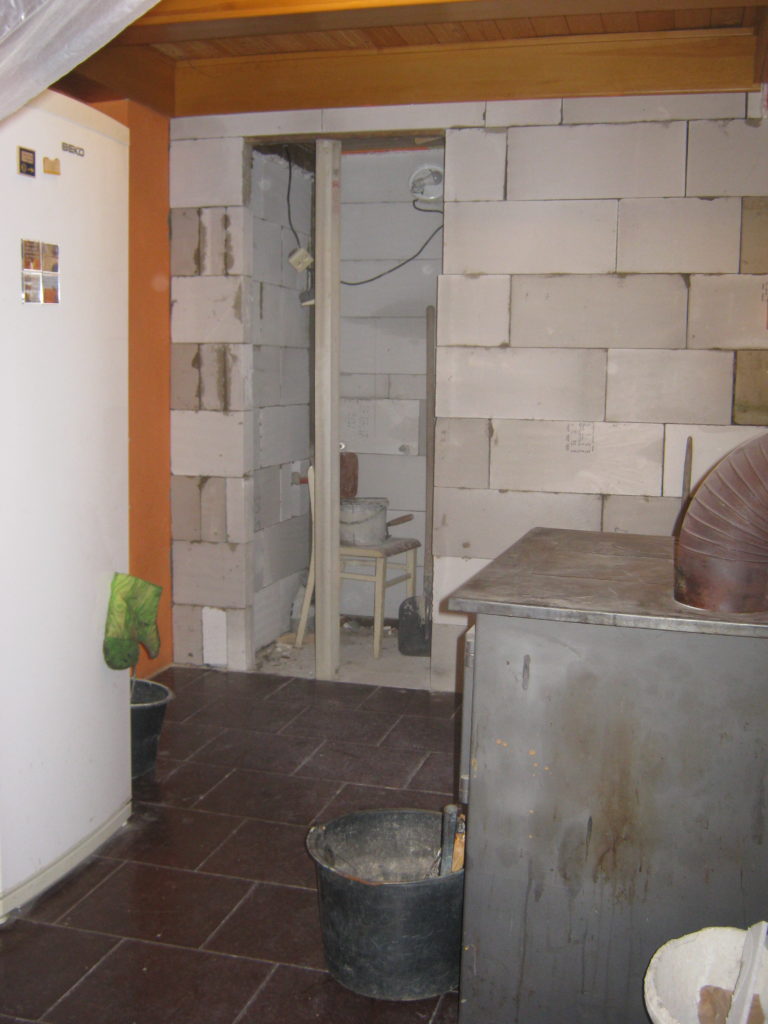
After four days of work, the walls of the shower room had been re-built.
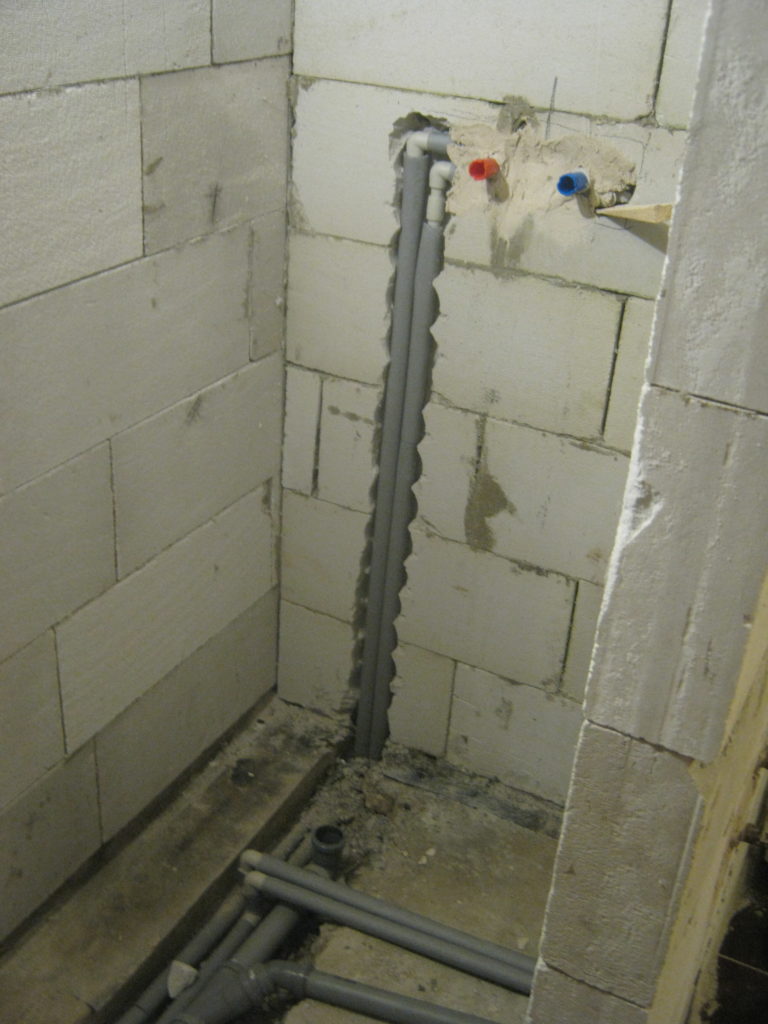
Then, after one day when no further work was done, on Saturday 13th January came the plumbers. They carved channels in the breeze block walls and dug up the shower room floor to install new water and waste pipes.
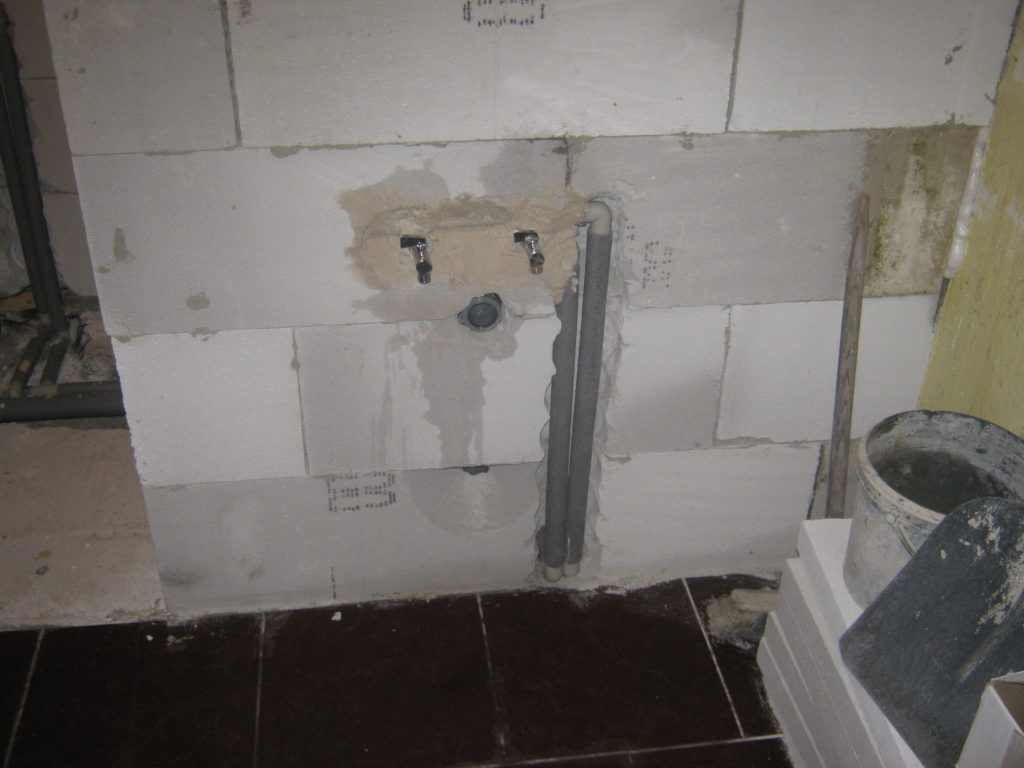
These ‘taps’, eventually to be the supply for the new kitchen sink, were then for several days, my only source of hot and cold water.
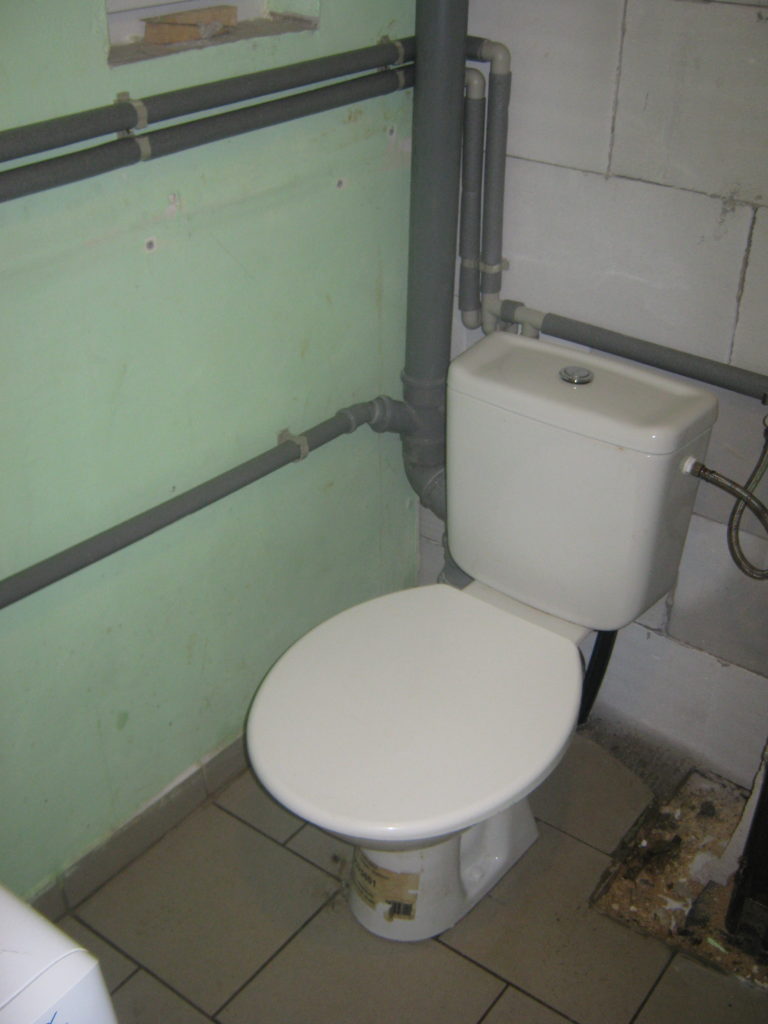
And after several hours without one, at the end of the day, I once more had a fully-functioning toilet 🙂
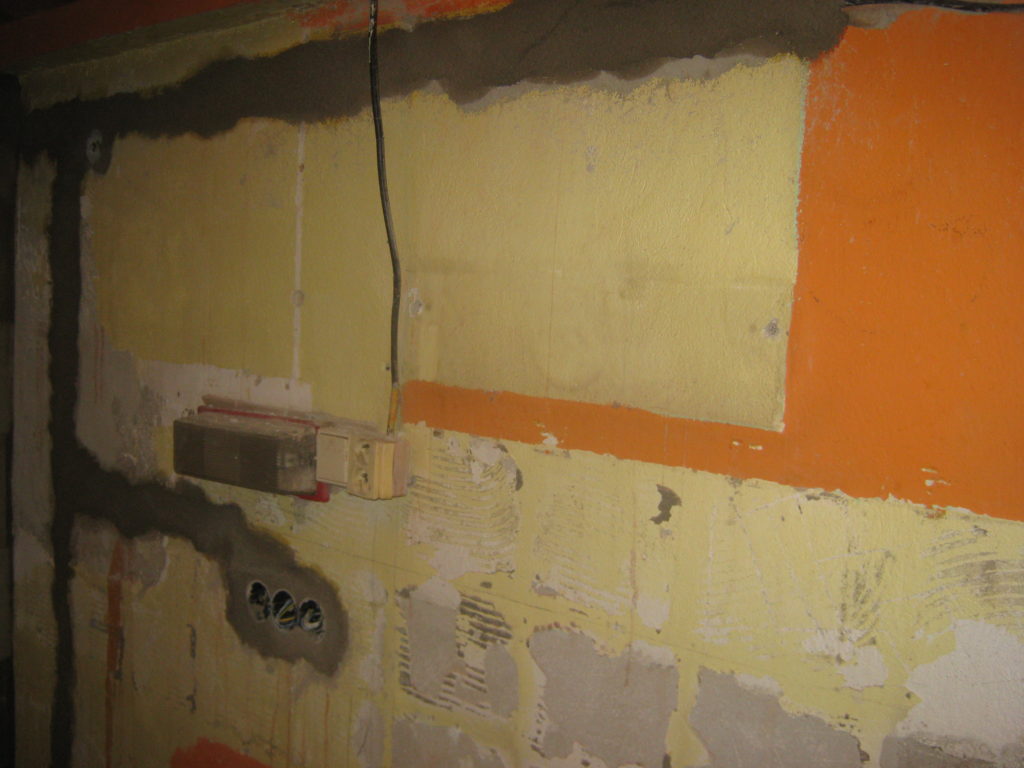
Monday 15th January saw the arrival of two electricians. They also carved channels into walls to install all the new wiring for the cooking hob, oven, power points and lights.
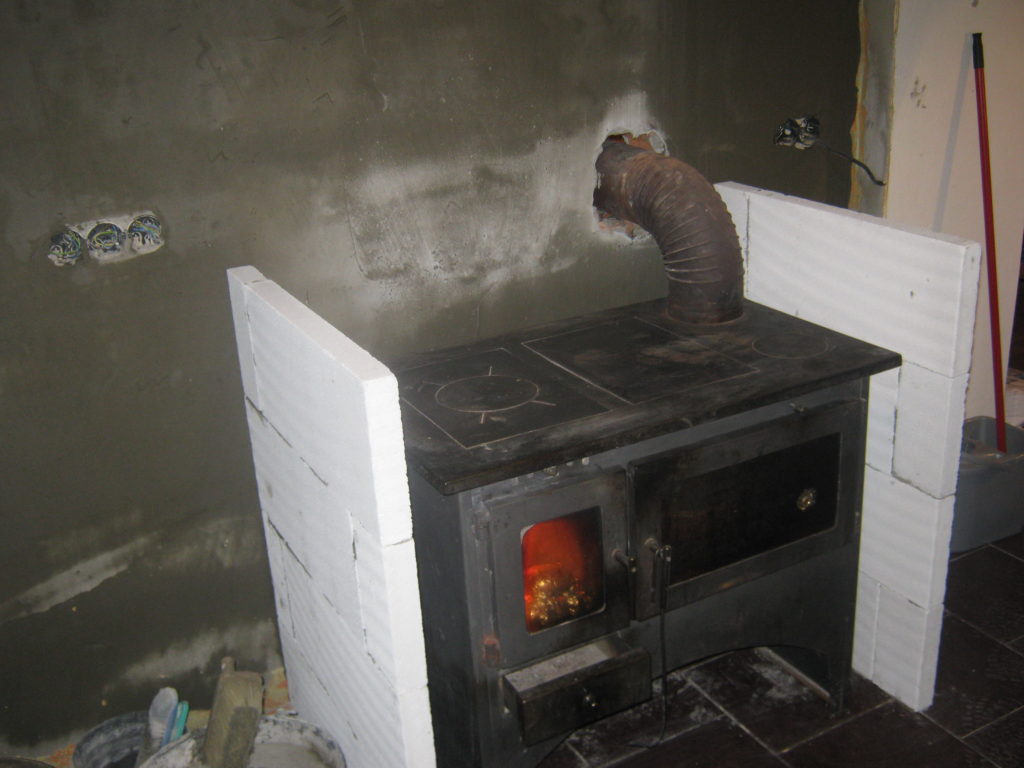
Over the next three days, the walls were rendered and made smooth, ready to be tiled or have wall units attached. The heatproof walls either side of the wood-burning stove were also constructed. Of course, I couldn’t use the wood-burning stove whilst this was done, leaving us all rather cold. But I did get roaring in the evening, not least to help dry out the render on the walls.
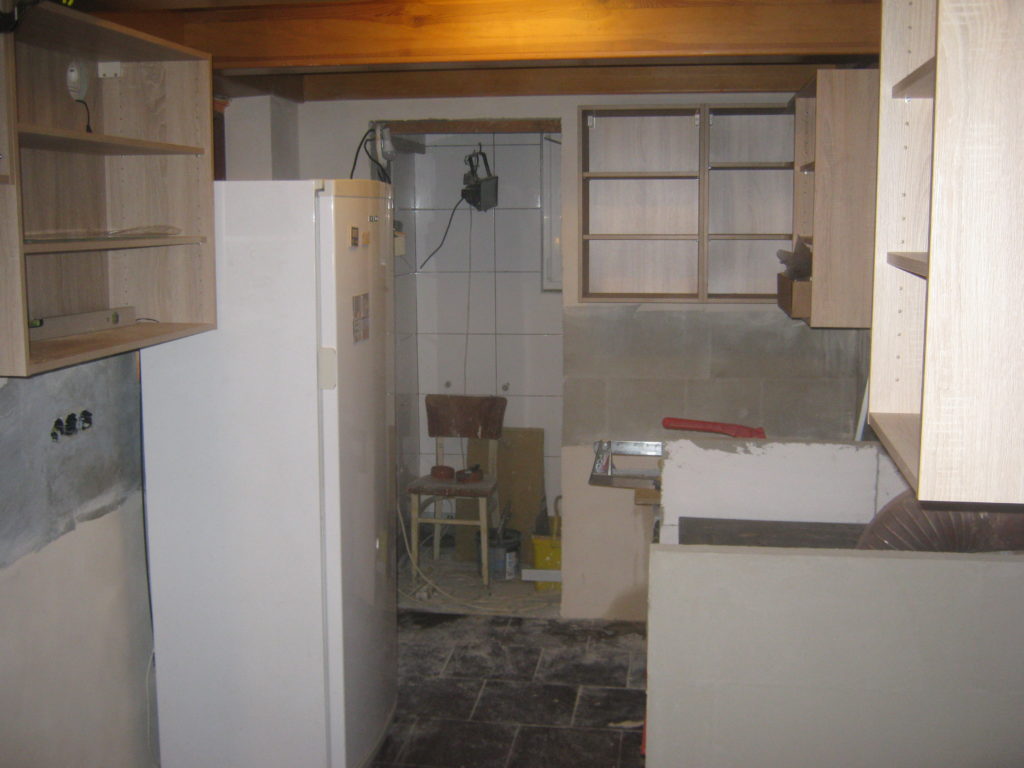
By the end of the second week since work began, tiling was commenced in the shower room and the first of the kitchen units were attached to the walls.
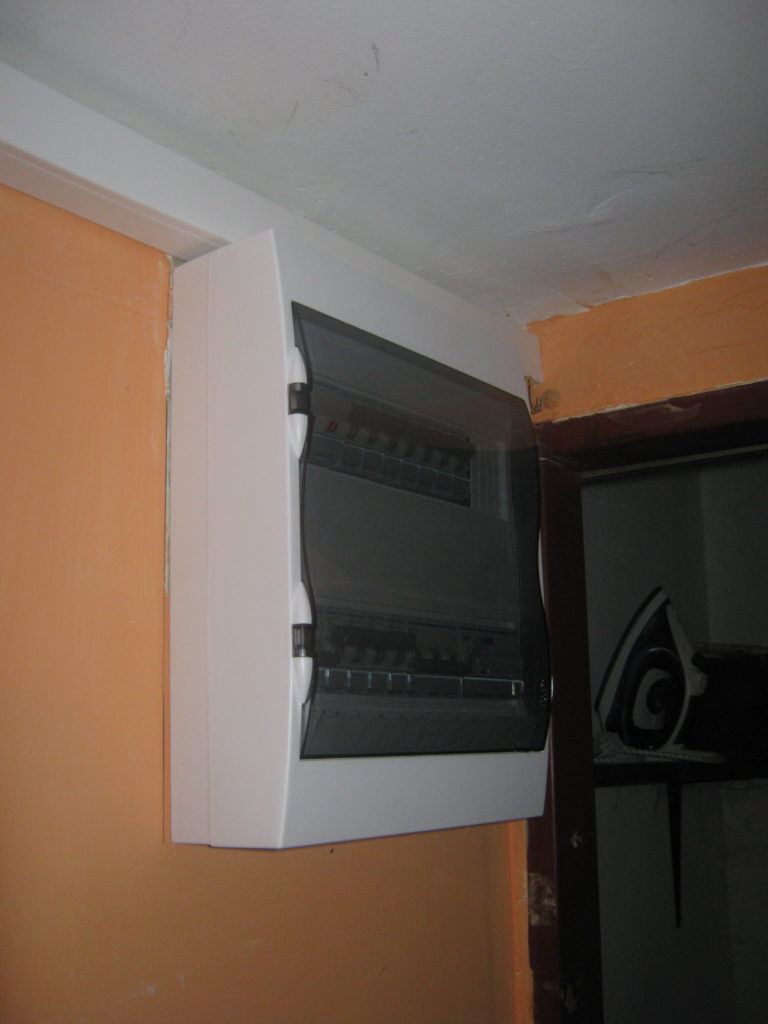
On Sunday 21st January, I was left without electric power for over four hours whilst the electrician fitted this new set of circuit breakers/trip switches, successfully connecting all of his new wiring, as well as the existing wiring in the rest of the house.
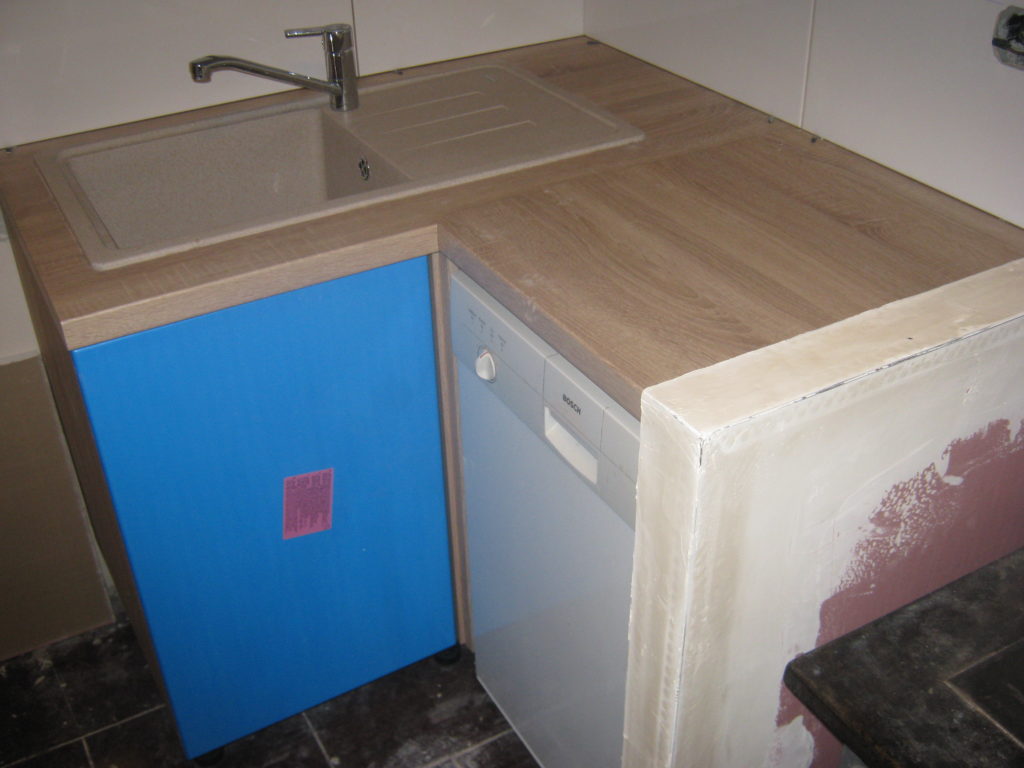
The beginning of the third week saw the installation of my new sink with running hot & cold water & a functioning waste pipe. And the following day, after eight months in hibernation, my dishwasher was slotted into its new home. Unfortunately, it still had to be connected to the cold water supply & waste water drain.
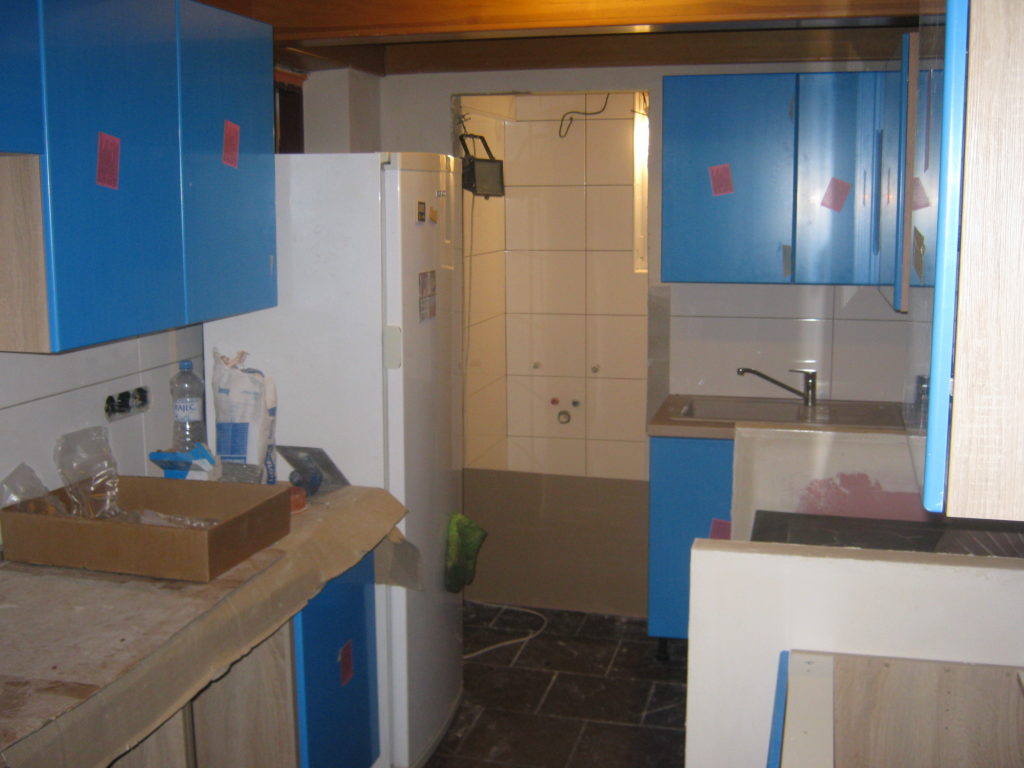
During the following days, the tiling in the shower room and kitchen was completed and all the new base units fitted.
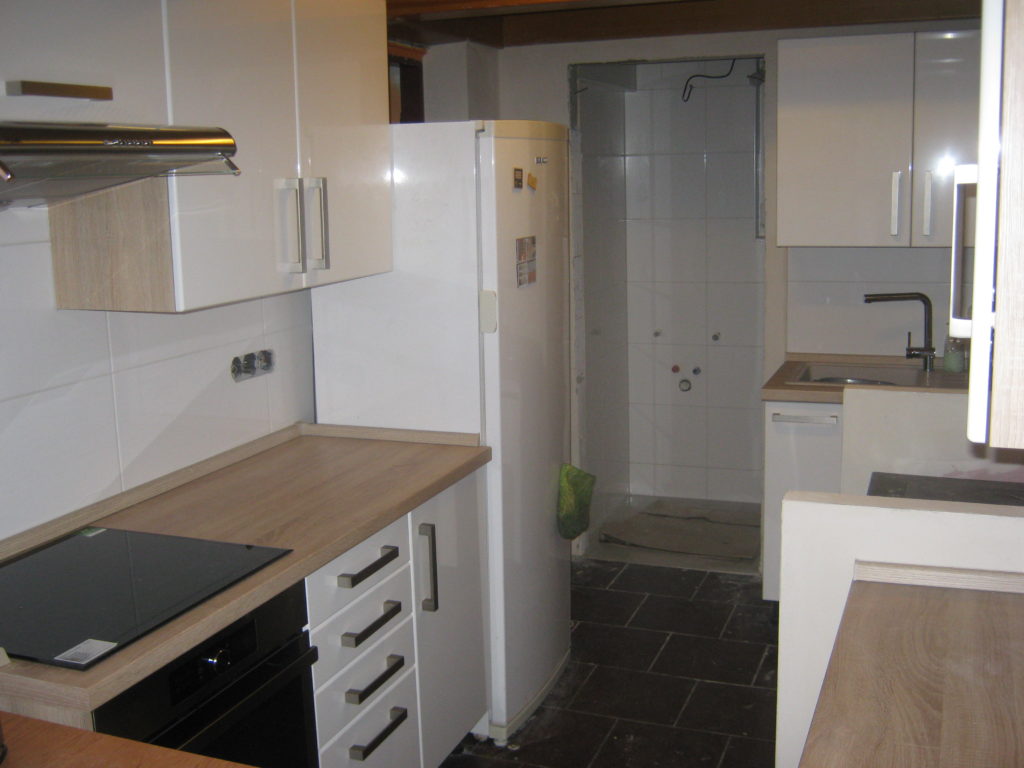
The cooking hob, oven and extractor hood were also installed.
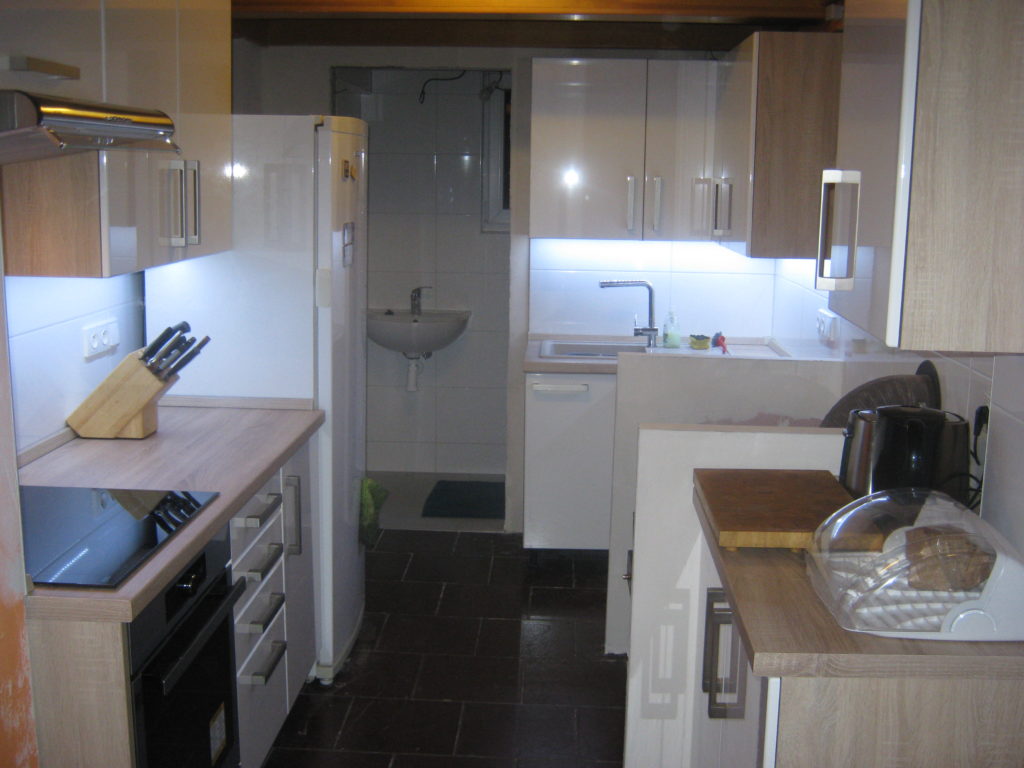
Then on Saturday 27th January, both the electrician and plumbers returned. By early Saturday afternoon I finally had a fully functioning cooking hob, oven, extractor hood, power points, dishwasher, together with a washbasin & shower with running hot & cold water 🙂 🙂 🙂
Whilst I’m very pleased with the end result, living in the midst of a building site was not pleasant 🙁 Firstly, I never envisaged that the work would last for just over three weeks – a few further things were not completed until Monday 29th January.
Secondly, there was dust – everywhere. On the first day, the boss did erect a supposedly dust-protecting clear plastic zip-up door at the entrance to my study-bedroom. It helped, but the room still suffered. The rest of the downstairs had no protection. Dust came, initially from the demolition work, then from cutting breeze blocks. After that, it was the plumbers and the electricians, carving out channels in the walls and floors for their pipes and wires. Whilst after all that was complete, things did improve, latterly I still had the tiler cutting tiles 🙁
Then the everyday problem was how to wash and shave – I wasn’t able to have a shower for nearly three weeks!
I shaved each day, getting hot water into a plastic bowl, placing it on top of the chest of drawers in my bedroom, alongside the mirror on a stand that I normally only use for combing my hair.
To wash the rest of my anatomy, I made use of the baby bath that I still have from when my children, (now aged 37 and 33 🙂 ), were small. Since they ceased to use it for its original purpose, it has served as the perfect means of taking wet washing from the washing machine, to wherever it needs to be hung out to dry. I filled it with hot water, took it to my bedroom, knelt over it to wash my hair and stood in it to wash the rest of me.
The whole experience of doing this, reminded me of my early childhood. The house in which I lived until I was ten years old, had no heating in the bathroom. So in the winter months, I would have a bath once a week, sitting in a tin bath in front of an open fire, in the living room.
The other issue to cope with was having all of this work done in the middle of winter. On at least three mornings, the first thing I had to do was get outside and scrape away overnight snow from the path and the parking area at the front of the house, in advance of workmen arriving.
However, it is now done and I am still alive to tell the tale – just!



